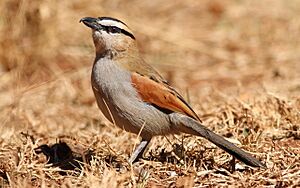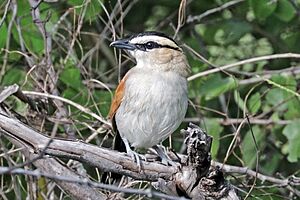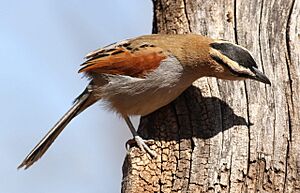Black-crowned tchagra facts for kids
Quick facts for kids Black-crowned tchagra |
|
|---|---|
 |
|
| Conservation status | |
| Scientific classification | |
| Genus: |
Tchagra
|
| Species: |
senegalus
|
| Synonyms | |
|
|
The black-crowned tchagra (Tchagra senegalus) is a type of bushshrike. These birds are related to true shrikes. They are found in the Arabian peninsula and most parts of Africa. You can spot them in scrubland, open forests, semi-deserts, and even farms.
Contents
Meet the Black-crowned Tchagra
The black-crowned tchagra is a very colorful bird. It is easy to spot! It grows to be about 19–22 cm long.
What Does It Look Like?
This bird has a solid black cap on its head. It also has black stripes around its eyes. These black parts are separated by a wide white stripe above its eyes. Its belly is light grey, and its back is light brown. When its wings are folded, they look chestnut-colored. Its tail is black with white tips. The bird's beak is black.
Male and female tchagras look quite similar. However, young birds have a brown cap instead of black. Their beaks are also a pale yellow. There are many different types, or subspecies, of this bird. They can vary in size and the color of their back, belly, and eye stripe.
Listen to Its Song!
The black-crowned tchagra has a special whistling song. It sounds like chee-chee chee cheroo cheroo. If you imitate this call, the bird might fly closer to see who is in its area! The male bird also has a cool display flight. He flies up and down in a special way to show off.
Life and Habits of the Tchagra
The black-crowned tchagra is similar to shrikes in how it lives. It hunts for insects and other small creatures. It usually watches from a branch in a bush.
Nesting and Young Birds
Female tchagras lay two or three white eggs. These eggs often have many markings on them. They build their cup-shaped nests in trees or bushes. Both parents help to incubate the eggs. This means they sit on them to keep them warm. The female does most of the incubating. The eggs hatch after about 12–15 days. The baby birds, called chicks, then stay in the nest for another 15 days before they are ready to fly.




